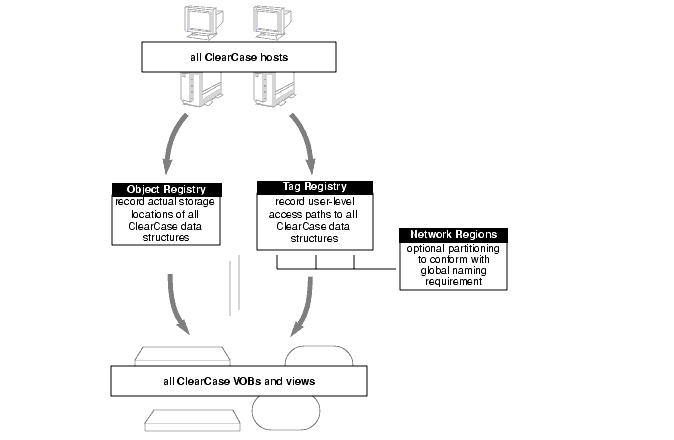


|
ClearCase maintains a networkwide registry of VOBs and views so that users and programs can access these objects without having to know the details of where they are stored.
The ClearCase registry database is maintained on the registry server host. Because access to the registry and the information it contains is critical for nearly every ClearCase operation, this host should be robust, accessible, and highly available. It should also be backed up regularly.
Your ClearCase network must have at least one registry server host. You may have additional registry server hosts if needed. Consider setting up an additional ClearCase registry host to accommodate disjoint user communities who need not (or must not) access each others VOBs and views. Otherwise, we recommend configuring a single ClearCase registry host per site to minimize registry administration overhead.
The ClearCase registry contains two types of information for every VOB and every view:
A single object entry that describes where the VOB or view is stored on the network (a host name and storage directory, for example) and includes other information needed by ClearCase.
One or more tag entries that define the name by which the VOB or view is referenced by other programs and provide a global path, expressed using network file naming conventions, to the VOB or view storage directory.
NOTE: ClearCase administrators in charge of mixed networks of UNIX and Windows hosts must be aware of several issues regarding VOB and view access in this environment. See Chapter 7, Configuring VOB and View Access in Mixed Environments, for more on this topic.
Because network file naming conventions are different on UNIX and Windows, a VOB-tag or view-tag that works for a UNIX host does not work for a Windows host. For example, a network file name in a UNIX network is typically expressed, using the naming conventions of the UNIX Network File System (NFS) protocol, in terms of a mount point, host name, and exported directory name:
/net/mercury/usr1
On Windows, a network file name takes the form of a Universal Naming Convention (UNC) path, expressed as a host name and a share name
\\mercury\usr1
Because of these and other differences in network naming, any VOB or view that has to be accessed by both UNIX and Windows clients has to have two tags: each with the network path to the VOB or view storage expressed using the appropriate syntax. To accommodate this requirement, the ClearCase registry can include multiple regions, each of which includes tags appropriate for use by either UNIX or Windows hosts (but not both).
In addition to the differences in the network file names they contain, tag names themselves are usually different between UNIX and Windows. Because a VOB has to be mounted (using the NFS mount command) on UNIX, a UNIX VOB tag usually has two components: a mount point and a tag name:
/vobs/sources
The mount point is not required by ClearCase, but using it conserves resources in the UNIX client's root partition and simplifies use of the NFS automounter to mount VOBs when a host starts up. Windows VOB tags only have a single component, for example:
\sources
Figure 1 illustrates how registries mediate access to VOBs and views.
Figure 1  ClearCase Storage Registries.
ClearCase Storage Registries.
In addition to VOB and view tag and object entries, the ClearCase registry records the names and network paths for server storage locations that can be created to provide a standard or default storage location for newly created VOBs and views. Because they include network file names, server storage locations are specific to a UNIX or Windows registry region.
Creating server storage locations on appropriate devices-a Network Attached Storage (NAS) device or a dedicated VOB or view server host-can simplify the creation, management, and maintenance of VOBs and views.
|
Feedback on the documentation in this site? We welcome any comments!
Copyright © 2001 by Rational Software Corporation. All rights reserved. |